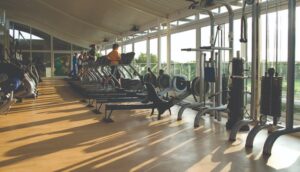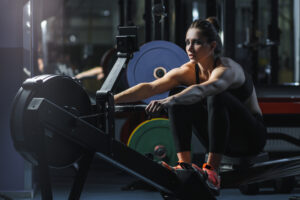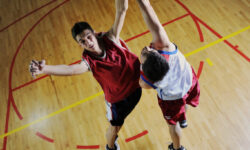
The rowing machine is one of the most versatile, effective pieces of equipment on the Outlooks Gym floor. According to governing body British Rowing, each stroke on a rowing machine uses 85 per cent of your muscles and burns upwards of 300 calories in 30 minutes.
It is also one of the most under-used pieces of equipment. No matter how busy the gym is, you are always likely to find a rowing machine free to use.
One tough challenge
Some of this is because gym-goers are worried that they are not using the correct technique; for others, the controlled pace of the rowing machine means they feel they are not putting in maximal effort; while other people find it is just too tough!
For people who skirt round the rowing machine because they are worried about technique, here are some pointers from the Concept 2 team.

Mastering the perfect rowing technique
The Catch
This is where the oar would enter the water in a real boat. With your knees bent and together, lean forward from your hips with your arms straight out in front of you gripping the handle. Don’t split your knees to try and lean further forward or bend with your back.
The Drive
The stroke should begin with the legs, the most powerful part of the body. Keep your back straight throughout. As your legs straighten, lean back slightly from the hips and pull the handle to your chest. Finish with your legs straight, leaning slightly back, and the handle just below your chest. Having your elbows by your sides encourages a more efficient stroke.
Recovery
Where the oar exits the water. Don’t lift the handle over your knees on the way back to the catch, this lengthens the handle’s route to the starting position and would capsize a real boat. Get the handle back to the starting position in the shortest distance possible: a straight line.
Timing and Focus
There should be no stationary period. Think of your whole body like a muscle and apply the same technique. The drive is the explosive part and should be completed on a count of one, whereas the recovery should be completed on a count of three.
Tortoise and hare principle
A smooth technique at 25 strokes per minute is much faster than bad technique at 40 strokes per minute. Make sure to look ahead throughout your session – looking down or to the sides can affect your posture and throw you off your game.
The recovery is essentially the reverse of the drive. You should move your hands and arms away first, then lean forward from the hips and finally begin to bend your knees. Simplified, the action is legs-arms on the drive and arms-legs on the recovery.
Tailor the workout
When it comes to how to use the rowing machine it is like every other activity – you need to know what you want to get out of the exercise session.
For general fitness maintenance, weight loss or improving your cardio vascular fitness then a steady timed row is really effective.
To push yourself to a new level of fitness, then short sets of heart-pumping speed work is perfect.
Rowing can also be combined with other exercises to give you a really effective all over workout. Here is a Tabata-style workout, guaranteed to burn fat, tone muscle and leave you feeling as if you have left part of yourself on the gym floor.

Warm-up:
Light rowing for one minute at 18 Strokes Per Minute (SPM)
One minute medium rowing at 22 SPM
Hard rowing for one minute at 26 SPM
One-minute light rowing at 18 SPM
Interval 1:
10 seconds light rowing then 20 seconds hard rowing 8 times
Then, this circuit:
– 250m row + 25 squat jumps
– 200m row + 20 lunge jumps
– 150m row + 15 press ups
– 100m row + 10 squat thrusts (feet on seat)
– 50m row + 5 burpees
Interval 2:
1-minute sprint row as fast as you can, 30 seconds rest, 1-minute sprint
Cooldown:
3-minutes light rowing followed by stretching your glutes, hamstrings and quads







